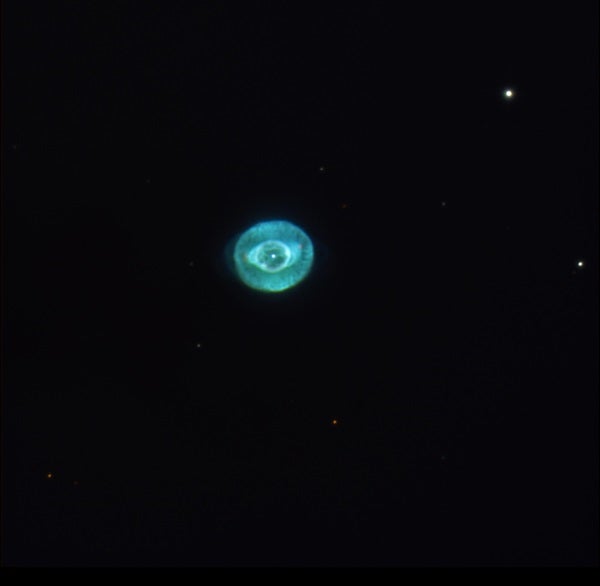This time of the year, the brighter constellations — like Leo, Ursa Major, and Boötes — tend to capture our attention to the north. Meanwhile, the sky’s longest constellation stretches along our southern horizon, passing largely unnoticed. Hydra the Water Snake spans a full one-third of the sky, bridging the gap between the fading winter sky and the bright stars of the summer to come.
Hydra’s brightest star, Alphard (Alpha [α] Hydrae), shines at 2nd magnitude, but none of the other stars that form its slinking figure break 3rd. This, coupled with its low altitude (for sky watchers in mid-northern latitudes), often means the Water Snake is devoured by horizon-hugging haze and light pollution.
But there are treasures hiding in Hydra that many amateurs ignore every spring. They are well worth the time and effort it takes to ferret them out, so let’s give it a go.
As you raise your binoculars toward Alphard, glance just 2° to its southwest for a lovely binary star. The 5th-magnitude primary is 27 Hydrae, while its 7th-magnitude companion is listed as HD 80550 (SAO 136767). The pair is separated by about 4′, making them easily resolvable. With 70mm and larger binoculars, 27 shows a subtle orangish hue for those with keen color perception.
Next, meander east from Alphard along the Water Snake’s sinuous body as it slinks toward the dim constellations Sextans, Corvus, and Crater. Pause at 4th-magnitude Mu (μ) Hydrae. NGC 3242, spring’s brightest planetary nebula, lies in the same field of view, 2° to Mu’s south. William Herschel was first to lay eyes on it in February 1785. Its popular nickname, the Ghost of Jupiter, was derived from William H. Smyth’s description in his classic 1844 observing guide, A Cycle of Celestial Objects. Although he didn’t coin the term, Smyth wrote, “From its size, equable light, and color, this fine object resembles Jupiter; and whatever be its nature, must be of awfully enormous magnitude.” Smyth was correct about its enormity: NGC 3242 measures about 2 light-years across its major axis. That’s about 50 percent larger than the Ring Nebula (M57).
At 8th magnitude, NGC 3242 is bright enough to see through 50mm binoculars even under the veil of moderate light pollution. Like its namesake planet, the Ghost of Jupiter appears about 40″ across. That means it will appear almost pinpoint at 7x to 10x magnification. But with a good chart of the area, you’ll be able to pick it out. If you have keen color perception and 70mm or larger binoculars, you just might see a hint of its characteristic color. Some describe it as blue, while others say green.
Speaking of color, two of spring’s most colorful carbon stars are also hiding in Hydra. Carbon stars appear especially red thanks to their carbon-rich atmospheres, which absorb shorter blue wavelengths of light. Just how red they appear will depend on how bright they are at the time, as they are variable stars. You can enhance their color by slightly defocusing your binoculars, but don’t go more than one-eighth of a turn.
To find these two targets, hop east along the Serpent’s body to Nu (ν) Hydrae. The first, U Hydrae, shines around 5th magnitude. Look for it about 4° northwest of Nu. It marks the south-pointing apex of a right triangle formed with two 6th-magnitude stars to its north. Studies show that U is about 3,400 times more luminous than our Sun and lies about 450 light-years away.
The other, V Hydrae, is found about 5° to Nu’s south. This one will take a little more patience to hunt down because of its greater variability. It is typically around 6th to 7th magnitude, but can fade as low as 12th. So if you can’t find it tonight, be sure to come back in the future and give it another try. At 2,000 light-years distant, V is much farther than U. It is also far more luminous: about 7,850 times greater than our Sun. V is actually a binary system, with a smaller companion star orbiting a red giant. Material is pulled from the red giant into a disk around the companion. When that material reaches a critical mass, about every eight years, it is ejected into space as blobs of hot plasma. Some astronomers suggest this process could portend a future planetary nebula. No doubt, V Hydrae is an exciting star to monitor and study.
Have a favorite binocular target? Let me know about it, so I can feature it in a future column. Contact me through my website, philharrington.net. Until next month, remember that two eyes are better than one.










